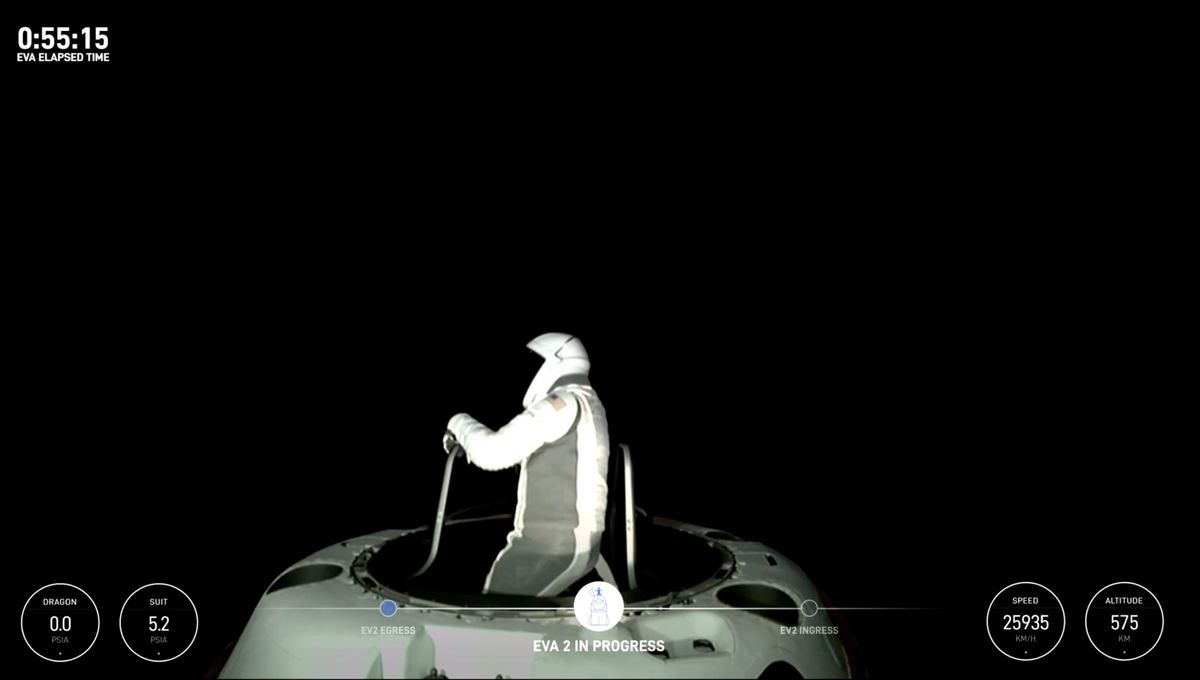
Today, Polaris Dawn Mission Commander Jared Isaacman and Mission Specialist Sarah Gillis made history, becoming the first people to conduct a spacewalk on a private mission.
This morning, the four crewmembers sat inside their spacecraft and waited as the cabin depressurized. Once complete, they were protected from the vacuum of space by nothing but newly designed Extravehicular Activity (EVA) suits.
“Developed with mobility in mind, SpaceX teams incorporated new materials, fabrication processes, and novel joint designs to provide greater flexibility to astronauts in pressurized scenarios while retaining comfort for unpressurized scenarios,” SpaceX explains of the new suit design.
“The 3D-printed helmet incorporates a new visor to reduce glare during the EVA in addition to the new Heads-Up Display (HUD) and camera that provide information on the suit’s pressure, temperature, and relative humidity. The suit also incorporates enhancements for reliability and redundancy during a spacewalk, adding seals and pressure valves to help ensure the suit remains pressurized and the crew remains safe.”
The suits performed well during the EVA part of the mission, keeping everybody safe as Isaacman and then Gillis climbed out of the hatch for a better look at Earth 737 kilometers (458 miles) below.
“SpaceX, back at home we have a lot of work to do,” Isaacman, CEO of Shift4 Payments, said as he first poked his head out of the capsule. “But from here it looks like a perfect world.”
While a commercial flight, with Isaacman’s close friend and former pilot Scott “Kidd” Poteet also occupying a seat, the mission is not just for jollies. Prior to the spacewalk, the crew, including two SpaceX engineers, flew further away from the Earth than any human has been since NASA’s Apollo missions in the 1970s.
To do so, they had to cross the innermost band of the Van Allen Belts, where they were exposed to the equivalent of three months’ worth of the radiation experienced by crew aboard the International Space Station.
“The Earth’s magnetosphere traps the high energy radiation particles and shields the Earth from the solar storms and the constantly streaming solar wind that can damage technology as well as people living on Earth,” NASA explains of the Van Allen Belts.
“These trapped particles form two belts of radiation, known as the Van Allen Belts, that surround the Earth like enormous donuts. The outer belt is made up of billions of high-energy particles that originate from the Sun and the inner belt results from interactions of cosmic rays with Earth’s atmosphere.”
Though not involved in the running of the SpaceX-led mission, NASA is conducting tests on board the spaceship too. The crew is involved in NASA’s Human Research Program on the effect of space conditions on human health, and will test a commercial device that collects and integrates key vital signs from them, including blood pressure, heart rate, respiration rate, and temperature.
“The technology also provides ultrasound imaging and larynx and throat-focused video camera capabilities, and includes an experimental telemedicine feature that could help diagnose crew members in near-real time,” NASA explains.
“Each mission, whether the crew is comprised of commercial or NASA astronauts, provides a key opportunity to expand our knowledge about how spaceflight affects human health,” Jancy McPhee, associate chief scientist for human research at NASA, added ahead of the mission. “Information gathered from Polaris Dawn will give us critical insights to help NASA plan for deeper space travel to the Moon and Mars.”
In total, the crew will conduct 36 experiments from 31 partner institutions, including NASA, before returning home on the sixth day of its mission.
Source Link: Polaris Dawn Crew Makes History With First-Ever Private Spacewalk